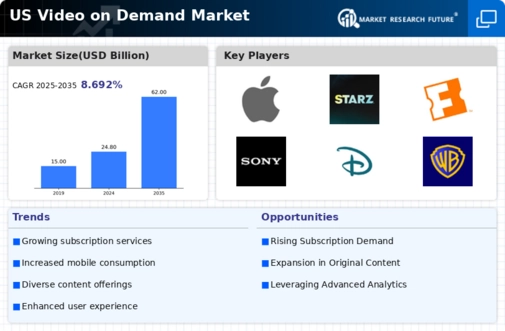The video on-demand market in the US is characterized by intense competition and rapid evolution, driven by technological advancements and shifting consumer preferences. Major players such as Netflix (US), Amazon Prime Video (US), and Disney+ (US) are at the forefront, each adopting distinct strategies to maintain and enhance their market positions. Netflix (US) continues to focus on original content production, investing heavily in diverse programming to attract a broad audience. Meanwhile, Amazon Prime Video (US) leverages its extensive e-commerce ecosystem to bundle services, enhancing customer loyalty through value-added offerings. Disney+ (US), with its rich library of beloved franchises, emphasizes family-oriented content, appealing to a demographic that prioritizes quality entertainment. Collectively, these strategies contribute to a competitive landscape that is both dynamic and multifaceted.
The business tactics employed by these companies reflect a nuanced understanding of market demands. For instance, localizing content to cater to regional tastes has become a common practice, enhancing viewer engagement. The market structure appears moderately fragmented, with several key players vying for dominance, yet the influence of major companies remains substantial. This competitive environment fosters innovation and encourages companies to refine their operational efficiencies, thereby shaping the overall market dynamics.
In October 2025, Netflix (US) announced a strategic partnership with a leading gaming company to integrate interactive gaming features into its streaming platform. This move is likely to enhance user engagement by offering a unique blend of entertainment options, potentially attracting a younger audience that seeks interactive experiences. Such diversification may not only bolster subscriber retention but also position Netflix (US) as a pioneer in merging gaming with traditional video content.
In September 2025, Amazon Prime Video (US) expanded its content library by acquiring exclusive streaming rights to several high-profile film franchises. This acquisition is significant as it not only enriches the platform's offerings but also strengthens its competitive edge against rivals. By securing exclusive content, Amazon Prime Video (US) aims to enhance its value proposition, thereby increasing subscriber growth and retention in a crowded marketplace.
In August 2025, Disney+ (US) launched a new initiative focused on sustainability, pledging to produce all original content using renewable energy sources by 2030. This commitment reflects a growing trend among consumers who prioritize environmentally responsible practices. By aligning its operational strategies with sustainability goals, Disney+ (US) not only enhances its brand image but also appeals to a socially conscious audience, potentially driving subscriber growth in the long term.
As of November 2025, the competitive trends in the video on-demand market are increasingly defined by digitalization, AI integration, and sustainability initiatives. Strategic alliances are becoming more prevalent, as companies recognize the value of collaboration in enhancing their service offerings. Looking ahead, competitive differentiation is likely to evolve, shifting from price-based competition to a focus on innovation, technology, and supply chain reliability. This transition suggests that companies will need to invest in cutting-edge technologies and sustainable practices to remain relevant in an ever-changing landscape.

















Leave a Comment